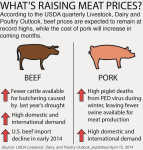Meat prices may push consumers to rethink purchases

Nevada Daily Mail
The latest results from the USDA Livestock, Dairy, and Poultry Outlook aren't wallet-friendly for meat buyers.
The first quarterly report for 2014, published in mid-April, gives an overview of livestock and poultry prices for both commercial and retail buyers. The statistics on beef and pork estimate high prices for consumers through the next few months.
The report said that retail prices on beef were at "record levels," and are expected to remain high as demand for beef and limited inventories contribute to the cost.
Because of those reduced numbers, cattle slaughter has been low for the first few months of the year. The livestock report said commercial cow slaughter for January through March is on track to be the lowest since 2008. Steer and heifer slaughter during those months could set a trend for the lowest slaughter since 1965.
The USDA suggests that the best way to increase those numbers would be a year of normal rainfall. Increased precipitation would allow farmers and ranchers to expand herds in an effort to bring down beef prices.
But for pork producers, a different issue is expected to increase the price of pork over the coming months.
Since it's discovery in the U.S. last year, PEDv, or porcine epidemic diarrhea virus, has killed a portion of piglets that would have gone to slaughter. The reduced number of pigs means a higher demand for pork than what can be supplied.
In March, pork economist Steve Meyer estimated a loss of more than 5 million piglets. He guessed that 1.3 million succumbed to the virus in January alone.
In a National Pork Board press release, Meyer said fewer pigs on farms gives remaining swine more room to grow, meaning higher market weights that will help keep prices down -- but not by much.
"Today we are already seeing summer pork futures climb to record levels," he said.
The USDA report estimates that U.S. pork customers could pay as much as $3.90 per pound for pork cuts during the summer months.
Meyer told the Daily Mail in February that higher pork prices would help farmers make up for the losses experienced from PEDv. But while high prices may benefit farmers, consumers could look at other mealtime options.
"It is not inconceivable that consumers could begin to look for alternative protein sources with beef prices at record levels," the quarterly livestock report said. "High prices for all meats and poultry could drive grilling season away from the higher priced beef cuts toward ground beef, pork, and poultry."
Davola Garrett, manager at Cubbage Country Market, said the increasing price of meat has caused noticeable changes in how her customers shop.
"More customers are watching what is on sale and are purchasing those items," she said. "We've also seen an increase in the purchase of meat packs and larger quantities of meat."
Garrett said the meat packs are a deal for customers because they give shoppers a bargain -- more meat at a bulk price.
What her customers are doing -- buying in larger quantities and watching for sales -- is a recommendation echoed by Tammy Roberts, a nutrition and health education specialist from Bates County Extension.
Roberts said families looking to save money on their grocery bill don't have to scratch beef or pork off the shopping list.
"Beef and pork both provide an excellent source of protein that most people aren't ready to give up," she said.
Instead, she suggested families should stick to recommended serving sizes to cut down on costs.
"The average American adult only needs 5 ½ ounces of meat or meat alternate per day," Roberts said.
She also recommended cooks use all of the meat they purchase by making new meals out of leftovers, or extend meat by making it part of a mixed dish or casserole.
